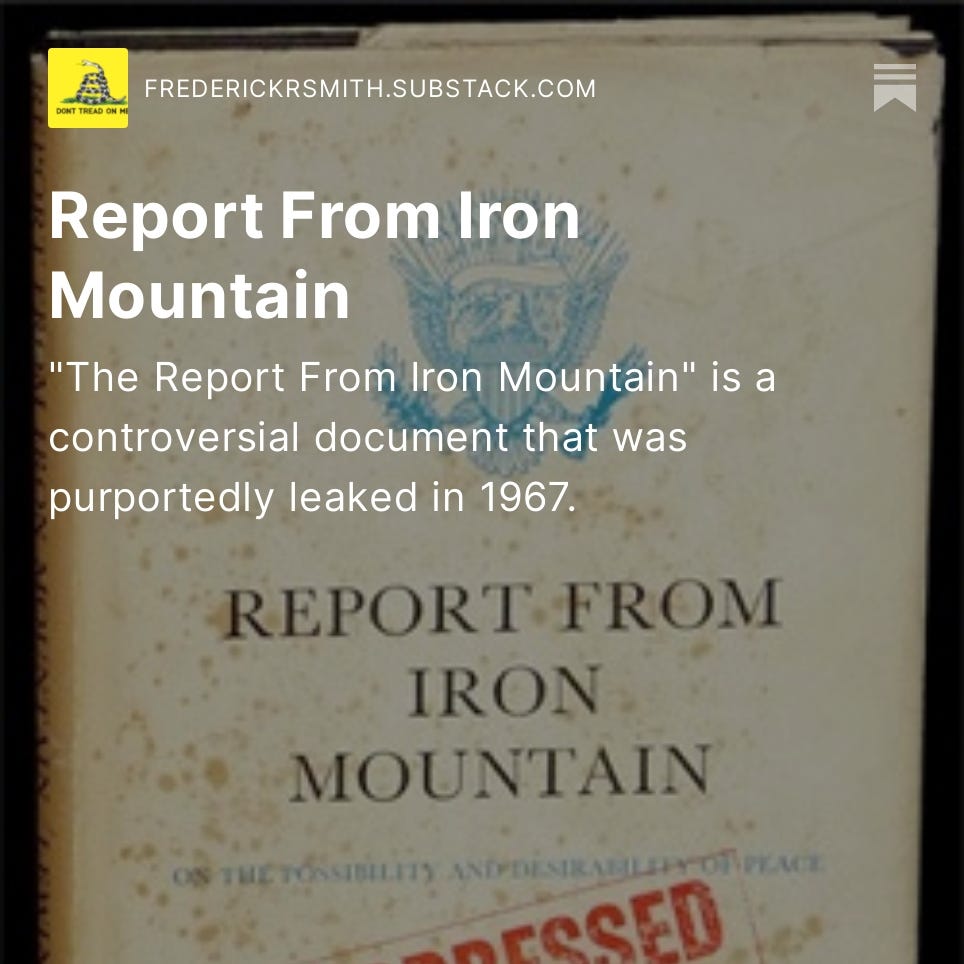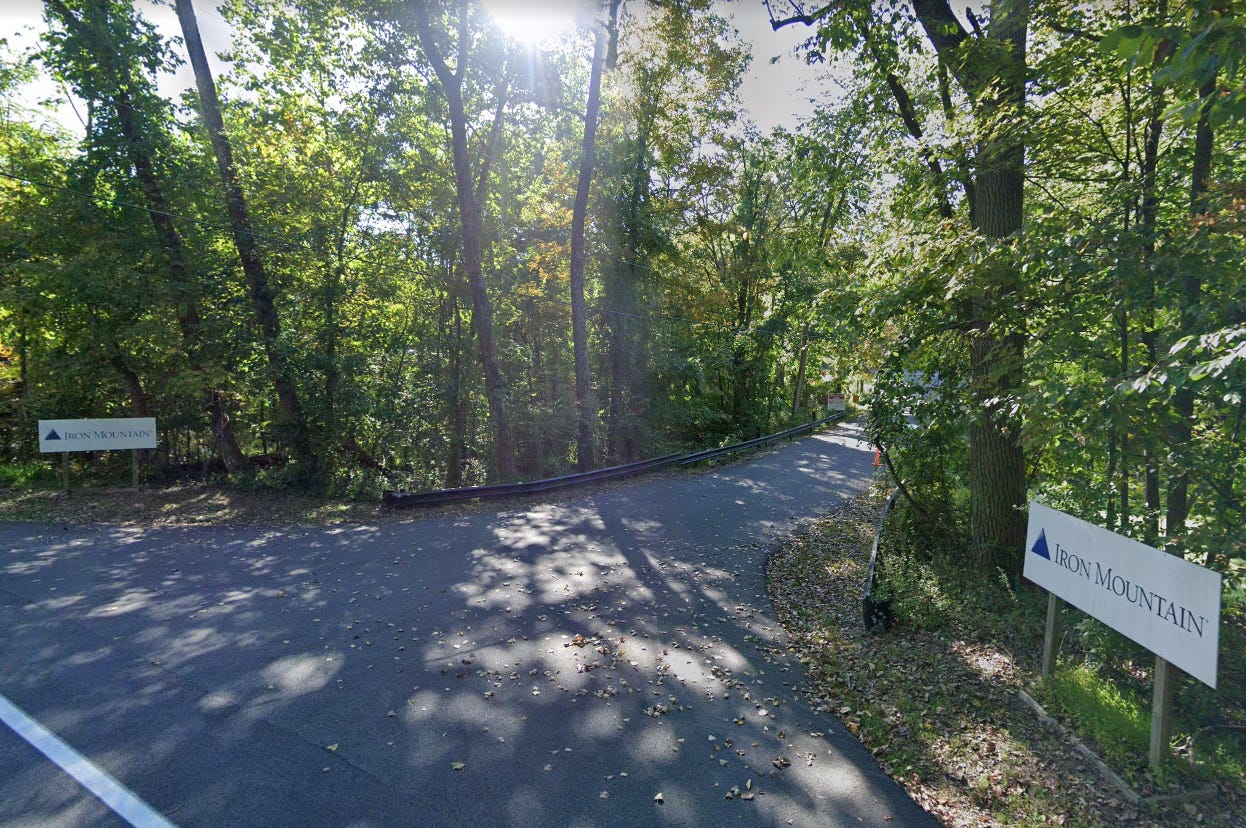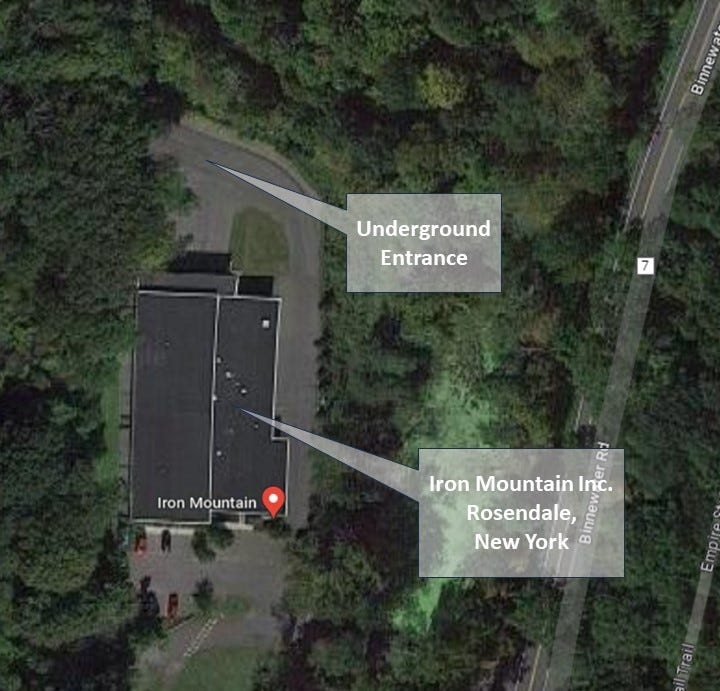Report From Iron Mountain
"The Report From Iron Mountain" is a controversial document that was purportedly leaked in 1967.
The most commonly held theory is simply that general economic reinvestment would absorb the greater part of these capabilities. Even though it is now largely taken for granted (and even by today’s equivalent of traditional laissez-faire economists) that unprecedented government assistance (and concomitant government control) will be needed to solve the “structural” problems of transition, a general attitude of confidence prevails that new consumption patterns will take up the slack. What is less clear is the nature of these patterns.
Report From Iron Mountian
Introduction
The Report From Iron Mountain is a controversial document purportedly leaked in 1967. It claimed to be a secret government report discussing the consequences of lasting peace and proposed methods to maintain social control in the absence of war.
However, its authenticity has been widely questioned, with many scholars and experts considering it a literary hoax or a satirical piece. Which is probably disinformation to “discredit” the publication to the public. However, who writes a report of that size, depth, and magnitude and then discredits it?
The true origins and intentions of the report remain unclear to this day. Of course, legacy media claims the report is a clear-cut case of political satire, inspiring some to write a “right-wing manifesto.” Read on, enjoy the ride, and decide for yourself.
Background
As the story goes…
In 1961, during Kennedy’s time as President, a study started that resulted in the Report From Iron Mountain. As claimed by one source, officials like McGeorge Bundy (1919-1996), Robert McNamara (1916-2009), and Dean Rusk (1909-1994) initiated this study. McGeorge Bundy associated himself with the Council on Foreign Relations (CFR), Bilderberger, Skull & Bones. Robert McNamara was a Trilateralist, CFR, and Bilderberger member. Dean Rusk had connections with CFR and Bilderberger. President John Kennedy (1917- 1963) wanted to end the Cold War, but there was no plan for long-term peace. They worried.1
In early 1963, individuals formed a study group to address this concern. This group studied how to make peace, not war, like think tanks like Rand Corporation and Hudson Institute. The fifteen members of this group are not identified. People believe the group includes historians, economists, scientists, and others. The group was from all over the country but met at Iron Mountain. Near Hudson, New York, there was a vast underground corporate “nuclear hideout.”2 The Hudson Institute, a CFR think tank, located itself there. To protect against a nuclear attack, Iron Mountain included backup offices for Standard Oil of New Jersey and the Morgan Bank. The Rockefellers controlled them. The Manufacturers Hanover Trust and Dutch Shell Oil, led by Bilderberger founder Prince Bernhard, were also there.
Someone named “John Doe,” a professor from a “large midwestern University” leaked a copy of the Report From Iron Mountain. He claimed to have been part of the study. Dial Press published the report in 1967. John Doe agreed with the study’s findings but disagreed with the decision of the group to keep their work concealed from the public. He argued that the American people, whose tax money funded the study, had the right to know about its disturbing conclusions. But John Doe’s fellow authors worried that publishing the report too soon might cause people to lose trust because of its sensitive nature.
Few publicized the Report From Iron Mountain, and many dismissed it as a joke. But Dial Press, under the leadership of Richard Warren Baron (1923-2021), published it without disclaimers. It showed a severe tone with footnotes and global analysis. It challenges the idea it’s fiction. They finished the report in March 1966. The group wrote it when they got involved in Vietnam. Some believe it reflects the perspectives of the Iron Mountain Special Study Group (the authors).
The report says that war is the central social system in human history and still is today. The authors believe that war is the main force that keeps modern societies organized and stable. The authors worry that if the ruling class can’t explain or want wars, it could disband the military. They think this would be bad. Thus, it is essential to have clear plans for effective substitute institutions before eliminating the war system. We must also drop national sovereignty and the traditional nation-state to end wars. According to the authors, war is necessary for governments to keep their power over people. Thus, welcome to the Nasty New World Order.
Also, according to the report, war has always been essential for maintaining “social classes.” It helps control how different classes interact and gives a place for people who are not social. The Selective Service System controls hostile social groups, including dangerous elements.
The authors also provide ideas to assist those who face economic or cultural disadvantages. In a peaceful world, those in control might argue that modern slavery is necessary. This idea can mean private companies using prisoners or people stuck in jobs because of debt.
The report explores war and social control. People continue to debate and examine it. The suggestions in the report make you think about how things are in the US today. The “authors” listed possible alternatives to war.
Economic
A comprehensive social-welfare program, directed toward maximum improvement of general conditions of human life
A giant open-end space research program, aimed at unreachable targets
A permanent, ritualized, ultra-elaborate disarmament inspection system, and variants of such a system
Political
An omnipresent, virtually omnipotent international police force
An established and recognized extraterrestrial menace
Massive global environmental pollution
Fictitious alternate enemies
Sociological: Control function
Programs generally derived from the Peace Corps model
A modern sophisticated form of slavery
Motivational function
Intensified environmental pollution.
New religions or other mythologies.
Socially oriented-blood games
Combination forms.
Ecological. A comprehensive welfare program, or a master program of eugenic control.
Cultural. No replacement institution offered. Scientific. The secondary requirements of the space research, social welfare, and/or eugenics programs.
The authors acknowledged that it can be hard to find new enemies. Yet, they emphasized the need to uncover or create these threats. Their proposed substitutes for war are intriguing and reveal their mindset. In stunning prose, the report in Section 5 addresses population growth/control:
It has thus tended to reduce the apparent importance of the basic ecological function of war, which is generally disregarded by peace theorists. Two aspects of it remain especially relevant, however. The first is obvious: current rates of population growth, compounded by environmental threat of chemical and other contaminants, may well bring about a new crisis of insufficiency.
If so, it is likely to be one of unprecedented global magnitude, not merely regional or temporary. Conventional methods of warfare would almost surely prove inadequate, in this event, to reduce the consuming population to a level consistent with survival of the species.
The second relevant factor is the efficiency of modern methods of mass destruction. Even if their use is not required to meet a world population crisis, they offer, perhaps paradoxically, the first opportunity in the history of man to halt the regressive genetic effects of natural selection by war. Nuclear weapons are indiscriminate.
Their application would bring to an end the disproportionate destruction of the physically stronger members of the species (the "warriors") in periods of war. Whether this prospect of genetic gain would offset the unfavorable mutations anticipated from postnuclear radioactivity we have not yet determined. What gives the question a bearing on our study is the possibility that the determination may yet have to be made.
Another secondary ecological trend bearing on projected population growth is the regressive effect of certain medical advances. Pestilence, for example, is no longer an important factor in population control. The problem of increased life expectancy has been aggravated. These advances also pose a potentially more sinister problem, in that undesirable genetic traits that were formally self-liquidating are now medically maintained.
The report suggested making a secret agency for researching war and peace. The President would create it by order. This agency would be like the National Security Council. It would work without Congress, the media, or the public watching. The President would grant it non-accountable funds and hold it responsible. This agency’s primary goal would be “Peace Research,” which involves creating alternatives to war. Also, it would have the power to keep its actions and choices secret from everyone except the President. This secrecy is for the good of the public.
They are still determining if anyone ever considered or created a secret agency. There is no definite information available. The proposal sounds like a secret plan because it involves people from secret societies. These people have class-conscious objectives, as shown in the report. In the 1980s, the people from the Vietnam War also tried to start conflicts in Nicaragua. They were also part of events in the Middle East and Balkans in the 1990s.
Analysis
Leonard C. Lewin (1916-1999) received the manuscript from John Doe and called it a shocking document. Post-publication, some claim, including Lewin himself, that he was the author. He thought it needed clarification because it confusingly explained parts of American policy.
The Report From Iron Mountain debuted in 1967 and was published by The Dial Press. It went out of print in 1980. E. L. Doctorow (1931-2015) and Richard Warren Baron (1923-2021), editors at Dial, agreed with Lewin and Victor Navasky (1933-2023) to label the book as nonfiction when they published it. They also decided to deflect inquiries about its authenticity by pointing to the footnotes as evidence. The following is a list of the various publishers who printed the book after its initial 1967 release:
1990: Liberty Lobby published the book, saying it was a government document and free to use. This led to a copyright infringement lawsuit filed by Lewin against Liberty Lobby. The case resulted in a settlement, but the specific terms were private. Lewin got over a thousand bootlegged copies as part of the resolution.3
1993: Buccaneer Books published a new edition. They focus on reprinting political classics that are out-of-print. However, it is unclear if the original author authorized this edition.
1996: The Free Press published a new hardcover edition to fix the problem of unauthorized editions. Lewin authorized this edition, which featured a new introduction by Navasky and an afterword by Lewin. The opening and afterward emphasized that the book was a work of fiction and satire. They discussed the book’s early controversy and current attention from conspiracy theorists.
2008: Bridger House Publishers Inc. released a new paperback edition so readers could still access the book.
Leonard C. Lewin was an American author and journalist who played a crucial role in the publication of the Report From Iron Mountain. As reported by the Los Angeles Times:
Lewin, a liberal who campaigned for Eugene McCarthy in 1968, was born in New York City in 1916. In the early ‘40s, after his graduation from Harvard University with a degree in psychology, he became a union organizer in Hartford, Conn., with the United Electrical Workers. He later worked with his father at a sugar refinery in Indiana before moving back to New York in 1960 to pursue his writing career.
Assuming authenticity, anonymous individuals wrote it, and Lewin, who edited it (or wrote it), provided the introduction. He shared the report, but people disagreed and gave negative feedback. Later, Lewin claimed that the meeting and report were a joke he created. Regardless, the report spread and gained credibility, making readers uncertain about what to believe.
Several factors led people to consider the report as legitimate. Many people thought that Lewin, who seemed to know much about the government and globalists, wouldn’t create a hoax. Additionally, the report provided an in-depth analysis that would be absent in satire. Besides, if it were a satire, it would have had funny or exaggerated parts, but it didn’t.
The Dial Press, Inc. published the work and has connections to secret societies. This made people think it was real. In the past, people used satirical hoaxes to legitimize documents. It appears they followed an old Hegelian dialectic model called “thesis-antithesis-synthesis.”
Curiously Section 6 of the Report (Substitutes for the Functions of War) references three of the great science fiction writers of all time:
Another possible surrogate for the control of potential enemies of society is the reintroduction, in some form consistent with modern technology and political processes, of slavery. Up to now, this has been suggested only in fiction, notably in the works of Wells, Huxley, Orwell, and others engaged in the imaginative anticipation of the sociology of the future. But the fantasies projected in Brave New World and 1984 have seemed less and less implausible over the years since their publication.
Also, in Section 6, in a further nod to Orwell and the reality of slavery under a New World Order:
The traditional association of slavery with ancient preindustrial cultures should not blind us to its adaptability to advanced forms of social organization, nor should its equally traditional incompatibility with Western moral and economic values. It is entirely possible that the development of a sophisticated form of slavery may be an absolute prerequisite for social control in a world at peace. As a practical matter, conversion of the code of military discipline to a euphemized form of enslavement would entail surprisingly little revision; the logical first step would be the adoption of some form of “universal” military service.
The Iron Mountain Company
And yes, Virginia, there are indeed Iron Mountain facilities near Hudson, NY. Iron Mountain is a company that provides storage and information management services. They have locations in various cities, including the two near Hudson, NY. From their website:
For over 70 years, Iron Mountain Incorporated (NYSE: IRM) has been your strategic partner to care for your information and assets. A global leader in storage and information management services and trusted by more than 225,000 organizations around the world, including 95% of the Fortune 1000, we protect, unlock, and extend the value of your work—whatever it is, wherever it is, however it’s stored.
We create the framework necessary to bridge the gaps between paper, digital, media, and physical data and extract value along its lifecycle, helping to build your organizational resilience. And all this with a commitment to sustainability at our core.
Based on the above, Iron Mountain Company has existed since 1953. Thus, it was in business during the development of the Report From Iron Mountain. Below is one of the facilities located at 448 Broadway Ulster Park, New York. It is 27 miles south of Hudson and 121 miles south of Iron Mountain Peak.
A more intriguing facility is located at 692-694 Binnewater Rd., Rosendale, NY. It is 32 miles south of Hudson, NY.
From the same site as above, there is a hidden mountain entrance:
Iron Mountain Company is known for having several underground storage facilities around the world. And indeed, there is such a facility in Rosedale, NY at a former limestone mine. As quoted in the Insdier article Inside the secretive subterranean facility where a $5 billion business stores the files of Fortune 1000 companies:
… executives from some major companies — Exxon and Shell, for example — built sometimes-elaborate fallout shelters in the mine, where they would stay in the event a nuclear war broke out.
Apparently, Iron Mountain Company also has (or had?) an underground facility 10 miles north of Rosendale, NY, across the Hudson River in Germantown, NY. As the original facility, that likely was the underground location referenced in the Report From Iron Mountain.
One of its most famous underground storage facilities is in Boyers, PA. That is also built within a former limestone mine. These underground storage facilities are known for their secure and climate-controlled environment. That makes it ideal for preserving important records, documents, and other valuable assets. The underground storage helps protect these materials from environmental factors like temperature fluctuations, humidity, and natural disasters.
There is also a geological formation called Iron Mountain in New York State. It is part of the more extensive Appalachian Mountains range, extending from the northeastern United States to the southeastern states. The high point is located about 90 miles northwest of Hudson, NY.
Is it all a mere coincidence or a meaningful connection? Could there be a link between the Iron Mountain Company and the Report From Iron Mountain? Perhaps the report, written long before the Internet, inspired the creation of QAnon. Many open questions, indeed!
Conclusion
The Report From Iron Mountain presented several main points, assuming its authenticity:
The Necessity of War: The report argued that war is essential for maintaining social stability and providing a means for controlling and channeling human aggression.
War as a Social Institution: It portrayed war as a functional institution that serves various purposes, such as economic stimulation, population control, and fostering social cohesion.
Alternatives to War: The report explored the possibility of finding substitutes for war that could serve similar functions in maintaining social order, such as a hypothetical “peaceful” substitute like an environmental threat or a fictitious alien invasion.
Stability through War Pretexts: The report suggested governments should use potential war scenarios or exaggerated threats to keep the population united and compliant with government policies.
Limits of Peace: It questioned the feasibility and potential negative consequences of lasting peace, suggesting that societies might face challenges in maintaining stability without a common external enemy.
It’s important to emphasize that the authenticity of the Report From Iron Mountain is widely disputed. Many consider it a hoax or satire rather than a genuine government document. As such, the points presented in the report should be taken with caution and critically analyzed if referenced or discussed. Or it just might be a form of Psychological Warfare. Regardless, it sure seems to predict much of the society we live in today.
Big Bonus!
Here is a video featuring a liberal professor with credentials in many specialties, including gender history studies. She presents an alternate view of the report. Introducing Petra Goedde and “How the Report From Iron Mountain Exposed the Absurdity of Cold War Militarism.”
Goedde, associate professor of history at Temple University, spoke about the report on April 4, 2017, at the Mershon Center. Surprisingly, she delivered a fascinating and informative presentation. She is onto something, perhaps, but not saying it directly: left-wing PsyOps.
Since Goedde is a liberal, what she says has the endorsement of legacy media by default. On the other hand, others get tagged as right-wing conspiracy mongers—no such thing as left-wing mongers (and I have swampland for sale in Texas).
Bottom Line
When I see an Iron Mountain truck on the highway, the image of a secret bunker packed with elitists will emerge in my mind’s eye. In nightmares, the bunker is full of cogent people imprisoned by pickled-brain collectivist cultists. 📕
Sources
Hope of the Wicked: The Master Plan to Rule the World ~ Ted Flynn, 550 pages, Maxkol Communications, May 2000
Death in the Air: Globalism, Terrorism, and Toxic Warfare ~ Dr. Leonard G. Horowitz
Rule by secrecy ~ Jim Marrs, 480 pages, William Morrow (Publisher), April 2001
Report From Iron Mountain: On the Possibility and Desirability of Peace ~ full text, bibliotecapleyades.net
1967 True Fake News: The Guinness Book of Records Most Successful Literary Hoax ~ video. Note, at 6:28 there is an intriguing interview with a member of the Hudson Institute.
I warmly encourage you to consider becoming a paid subscriber if you have the means. Regardless of your choice, your support is deeply appreciated. From the bottom of my heart, thank you for your invaluable support!
Rule by Secrecy pg. 113. This book is the only source in my library that makes this claim, so the information in this paragraph is speculative.
It is well known that a secret bunker can be “hidden in plain sight.” An example is the Great Greenbrier Resort bunker in White Sulfur Springs, West Virginia.
The SPLC paints an ugly picture of the founder of Liberty Lobby, Willis Carto. Readers can make their own judgments.










Fascinating and frightening. When we lived in PA, we saw the Boyers facility and knew people who worked there.
Surely something that mostly becomes true is a plan not a fiction.
I haven't listened to all of Petra Goedde's lesson but found your article fascinating.